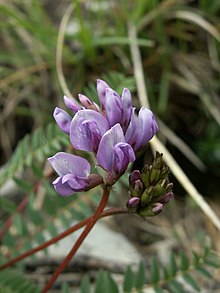This article includes a list of general references, but it lacks sufficient corresponding inline citations. (July 2020) |
| Oxytropis | |
|---|---|

| |
| Oxytropis jacquinii | |
| Scientific classification | |
| Kingdom: | Plantae |
| Clade: | Tracheophytes |
| Clade: | Angiosperms |
| Clade: | Eudicots |
| Clade: | Rosids |
| Order: | Fabales |
| Family: | Fabaceae |
| Subfamily: | Faboideae |
| Clade: | Inverted repeat-lacking clade |
| Tribe: | Galegeae |
| Subtribe: | Astragalinae |
| Genus: | Oxytropis DC. (1802) |
| Synonyms[1] | |
| |
Oxytropis is a genus of plants in the legume family. It includes over 600 species native to subarctic to temperate regions of North America and Eurasia.[1] It is one of three genera of plants known as locoweeds, and are notorious for being toxic to grazing animals. The other locoweed genus is the closely related Astragalus. Most oxtropis species are native to Eurasia and North America, but several species are native to the Arctic. These are hairy perennial plants which produce raceme inflorescences of pink, purple, white, or yellow flowers which are generally pea-like but have distinctive sharply beaked keels. The stems are leafless, the leaves being all basal.[2] The plant produces legume pods containing the seeds.
- ^ a b Oxytropis DC. Plants of the World Online. Retrieved 12 September 2023.
- ^ Taylor, Ronald J. (1994) [1992]. Sagebrush Country: A Wildflower Sanctuary (rev. ed.). Missoula, MT: Mountain Press Pub. Co. p. 102. ISBN 0-87842-280-3. OCLC 25708726.